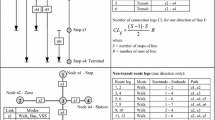Abstract
Park-and-Ride facilities are common in commuter transit systems as well as in metro network stations situated in residential areas. Catchment areas are useful for different purposes; in particular, to evaluate the coverage of transit lines, assuming that the population covered by the line bears relation to the expected number of trips.
In this paper, catchment areas for riderships using park-and-ride facilities are obtained by comparing the total travelling time using just private mode with that using a combination of both modes. This methodology leads us to establish a region whose boundary is typically a branch of hyperbola with foci located in the nearest station S from user and the destination D.
Moreover, when the trips in central and suburban districts are assumed with different average speeds, the curve limiting catchment areas is obtained and belongs to the same kind of conic curves.
Finally, the boundary between (level-)catchment areas of adjacent stations for riderships using park-and-ride facilities is also characterised as a branch of hyperbola, and an optimisation problem is proposed in relation with the line coverage.
Access this chapter
Tax calculation will be finalised at checkout
Purchases are for personal use only
Preview
Unable to display preview. Download preview PDF.
Similar content being viewed by others
References
Current, J., ReVelle, C. and Cohon, J. (1985). “The maximum covering/shortest path problem: a multiobjective network design and routing formulation”. European Journal of Operational Research 21, pp 189 - 199.
Dufourd, H., Gendreau, M. and Laporte, G. (1996). “Locating a transit line using tabu search”. Location Science 4, pp 1 - 19.
García, A. and Cristóbal, C. (1996). “Cobertura de las redes ferroviarias de transporte público (metro y cercanías) de la Comunidad Autónoma de Madrid, utilizando un sistema de información geografico”. II Simposium de Ingeniería de Transportes ( Madrid, Spain ), pp. 455 - 462 (in Spanish).
Plan Director de Infraestructuras para el Area Metropolitana de Sevilla (1998). Plan Director de Infraestructuras de Andalucia 19972007. Consejería de Obras Públicas y Transportes de la Junta de Andalucia ( Sevilla, Spain ), pp. 216 - 219 (in Spanish).
Bolger, D., Colquhoun, D. and Morrall, J. (1992). “Planning and design of Park-and-Ride facilities for the Calgary Light Rail Transit System”. Transportation Research Record 1361, pp 141 - 148.
Lutin, J.M. and Benz, G.P. (1992). “Key issues in light rail transit station planning and design”. Transportation Research Record 1361, pp. 117 - 124.
Love, R.F., and Morris, J.G. (1988). “On Estimating Road Distances by Mathematical Functions”. European Journal of Operational Research 36, 251 - 253.
Brimberg, J., Love, R.F. and Walker, J.H. (1995). “The Effect of Axis Rotation on Distance Estimation”. European Journal of Operational Research 80, pp 357 - 364.
Laporte, G., Mesa, J.A. and Ortega, F.A. (1998). “Location Stations on Rapid Transit Lines”. Accepted in Computers and Operation Research.
Ortúzar, J.D. and Willumsen, L.F. (1990). Modelling Transport. J. Wiley, New York.
Author information
Authors and Affiliations
Editor information
Editors and Affiliations
Rights and permissions
Copyright information
© 2001 Springer Science+Business Media Dordrecht
About this chapter
Cite this chapter
Mesa, J.A., Ortega, F.A. (2001). Park-and-Ride Station Catchment Areas in Metropolitan Rapid Transit Systems. In: Pursula, M., Niittymäki, J. (eds) Mathematical Methods on Optimization in Transportation Systems. Applied Optimization, vol 48. Springer, Boston, MA. https://doi.org/10.1007/978-1-4757-3357-0_5
Download citation
DOI: https://doi.org/10.1007/978-1-4757-3357-0_5
Publisher Name: Springer, Boston, MA
Print ISBN: 978-1-4419-4845-8
Online ISBN: 978-1-4757-3357-0
eBook Packages: Springer Book Archive




